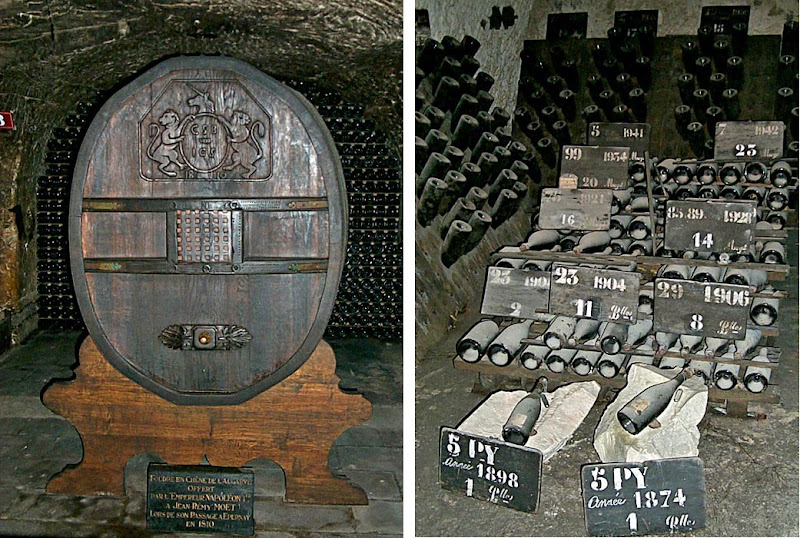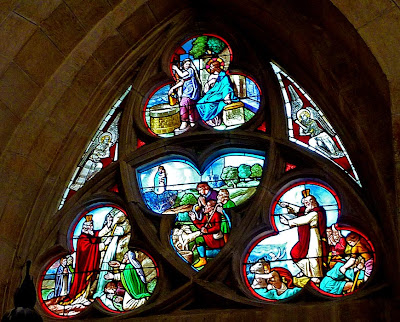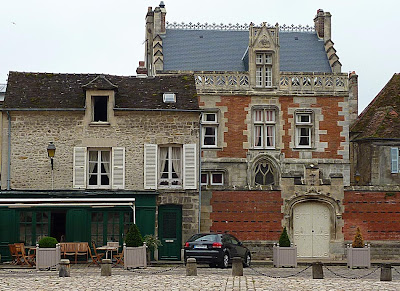A lot of people probably don't know that red wine is produced in the Champagne region. I know I didn't know it, until a few years ago.
I remember going to Champagne — the city of Reims, precisely — back in the early 1970s. I was traveling with a French woman I had met in Normandy — her son was a student of mine — and her two younger children. J. had lived in Reims as a young girl. Her husband was a
Rémois, and her mother-in-law lived in an old row house just across the street from the famous cathedral. We spent the weekend there.
 From October 2000: an oak barrel given by Napoléon
From October 2000: an oak barrel given by Napoléon
to Jean-Rémy Moët in 1810, and a display of very
dusty old bottles of champagne down in the caves
During the trip, J. bought some Champagne wines to take back home to Rouen. One of them was a still (not sparkling) white wine that was called
blanc de blancs de Champagne — white wine from white Champagne grapes. That's when I learned that still wines are also made in the region, along with the sparkling wines.
The major white wine grape grown in Champagne is Chardonnay, so the
blanc de blancs wine was a Chardonnay. Chardonnay is one of the grapes whose juice goes into sparkling Champagne wine. Still wines were produced in the Champagne region for centuries before the vinification techniques for turning them into effervescent wines were developed in the 1700s.
 I call this one « Aÿ-Aÿ-Aÿ ! »
I call this one « Aÿ-Aÿ-Aÿ ! »
Fast-forward nearly 30 years. Walt and I went to Champagne in October 2000, and J. met us there. We wanted her to show us the area, and to take us to meet and buy wine from her favorite producer of sparkling wine,
Alain Siret, located in a village called Gionges in the Côtes des Blancs district just south of Epernay. She did that.
She also took us to a grape-grower's house in the village of Bouzy, southeast of Reims and northeast of Epernay. I remember that we drove up to a modern house along a little road. I don't remember a sign saying wine was sold there, but maybe there was one. J. went up to the front door and rang the bell.
 J. and Walt in front of a restaurant
J. and Walt in front of a restaurant
in Le Mesnil-sur-Oger in Oct. 2000
A woman in a house dress answered the door. "We'd like to buy some wine," J. told her. All right, she said, come into the kitchen. We three went and sat at a formica table in the woman's rather plain, functional
cuisine while she went to get a bottle to open. We tasted it and bought a few bottles.
It was a red wine, not at all sparkling. I was surprised. J. said that while non-sparkling
blanc de blancs wines made in Champagne were harder and harder to find, local red wines were still available. I had never imagined that the Champagne producers also made still red wines. You almost never find them outside the region.
 Riddling racks at the Pommery champagne house in Reims
Riddling racks at the Pommery champagne house in Reims
The other important grape used in the sparkling wines of Champagne is Pinot Noir. So when you think about it, it's not surprising that some of that Pinot Noir gets made into still red wine. Pinot Noir is also the red wine grape of Burgundy, just a ways south of Champagne, and it thrives in cold climates — as does the Chardonnay grape.
One reason that it's harder to find non-sparkling Chardonnay wine in Champagne nowadays is probably the fact that there are two styles of sparkling champagne produced: the first and best known is the standard champagne, made with an
assemblage — a blend — of juices from both Pinot Noir and Chardonnay grapes (along small amounts of juice from other grapes). The Pinot Noir grape gives what is called
blanc de noirs — white juice or wine from red grapes — when the pressed juice is not allowed to remain in contact with the grapes' red skins.
The other style of sparkling champagne is made exclusively with Chardonnay grapes —
pur chardonnay — and is called, what else,
blanc de blancs. All the Chardonnay juice goes into sparkling wines nowadays.
Blanc de blancs the kind of champagne wine that I prefer. It doesn't give me a headache when I drink it. And it reminds me in that way of the Loire Valley's finest sparkling wine, Vouvray, which is made with 100% Chenin Blanc grape juice.
 Red wine from Mareuil-sur-Aÿ in Champagne
Red wine from Mareuil-sur-Aÿ in Champagne
A couple of weeks ago, driving through Champagne, I came upon a village named Mareuil-sur-Aÿ. I was surprised, because Walt and I live in the village of Mareuil-sur-Cher near Saint-Aignan. Then I spotted signs advertising a couple of local producers of sparkling Champagne wine. I had to stop and buy some. The producer I bought from is
Guy Charbaut, in that other Mareuil.
So I bought six bottles of champagne — three
assemblages, and three
pur chardonnay — along with three bottles of Coteaux-Champenois still red Pinot Noir wine. It was expensive, by my standards, at 14 euros a bottle — the same price as the bottles of sparkling champagne. I normally pay about four euros a bottle for Loire Valley red wines. But the Coteaux-Champenois is a Pinot Noir, after all, and it's a local delicacy up there in Champagne country.
 Notre-Dame de l'Epine in Champagne
Notre-Dame de l'Epine in Champagne The church is known for its gargoyles, many of which
The church is known for its gargoyles, many of which



















































